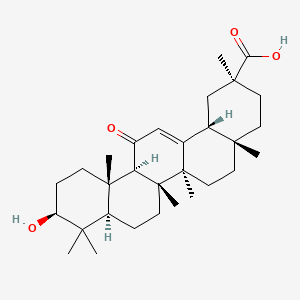Glycyrrhetinic acid
Glycyrrhetinic acid is a lipid of Prenol Lipids (PR) class. Glycyrrhetinic acid is associated with abnormalities such as Congenital Abnormality, Cortisol 11-beta-ketoreductase deficiency, Hypertensive disease, Mineralocorticoid Excess Syndrome, Apparent and Syndrome. The involved functions are known as Signal, Muscle Contraction, Pressure- physical agent, Agent and Metabolic Inhibition. Glycyrrhetinic acid often locates in Protoplasm, Body tissue, Muscle, Connexon and Extracellular. The associated genes with Glycyrrhetinic acid are SLC33A1 gene, GJB1 gene, RNU1-1 gene, HADHA gene and RNU1-4 gene. The related lipids are Steroids, Saponin, Octanols, Heptanol and amyrin.
References related to abnormalities published in Others
| PMID | Journal | Published Date | Author | Title |
|---|---|---|---|---|
| 10516121 | Am. J. Physiol. | 1999 | Horigome H et al. | Glycyrrhetinic acid-induced apoptosis in thymocytes: impact of 11beta-hydroxysteroid dehydrogenase inhibition. |
| 11980696 | Circulation | 2002 | Ferrari P | Endothelin 1 type a receptor antagonism prevents vascular dysfunction and hypertension induced by 11beta-hydroxysteroid dehydrogenase inhibition: role of nitric oxide. |
| 11007814 | Nephrol. Dial. Transplant. | 2000 | Frey FJ and Ferrari P | Pastis and hypertension--what is the molecular basis? |
| 9683905 | Cardiovasc. Res. | 1998 | van Uum SH et al. | The role of 11 beta-hydroxysteroid dehydrogenase in the pathogenesis of hypertension. |
| 17513608 | Mol. Cancer Ther. | 2007 | Chintharlapalli S et al. | Structure-dependent activity of glycyrrhetinic acid derivatives as peroxisome proliferator-activated receptor {gamma} agonists in colon cancer cells. |
| 15788515 | J. Neurophysiol. | 2005 | Vogalis F et al. | Electrical coupling in sustentacular cells of the mouse olfactory epithelium. |
| 16002718 | J. Immunol. | 2005 | Ukil A et al. | 18 Beta-glycyrrhetinic acid triggers curative Th1 response and nitric oxide up-regulation in experimental visceral leishmaniasis associated with the activation of NF-kappa B. |
| 25691644 | Antimicrob. Agents Chemother. | 2015 | Gupta P et al. | Antileishmanial effect of 18β-glycyrrhetinic acid is mediated by Toll-like receptor-dependent canonical and noncanonical p38 activation. |
